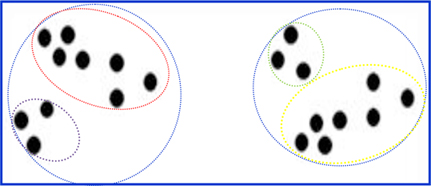Objectives
The objectives of this section are:
define clustering
outline the various application of clustering
delve into the various types of clustering
define the various types of clusters
introduce some popular clustering algorithms
Outcomes
By the time you have completed this section you will be able to:
list some of the applications of cluster analysis
define clustering
list the various types of clusters and clustering
list some of the well known clustering algorithms
Types of Clustering
Nesting:
Figure 1: Hierarchical Clustering

This separation is based on the characteristic of nesting clusters. Hierarchical clustering are nested by this we mean that it also clusters to exist within bigger clusters as shown in Figure 1 (shown to the right )while partitional clustering prohibits subsets of cluster as shown in Figure 2 below
Figure 2: Partitional Clustering

Exclusiveness:
 This separation is based on the characteristic that allows a data object to exist 1 or more than 1 clusters. Exclusive clustering is as the name suggests and stipulates that each data object can only exist in one cluster. Figure 2 above is an example as each object is only a member of one cluster. Figure 3 (to the right) is another example of exclusive clustering.
This separation is based on the characteristic that allows a data object to exist 1 or more than 1 clusters. Exclusive clustering is as the name suggests and stipulates that each data object can only exist in one cluster. Figure 2 above is an example as each object is only a member of one cluster. Figure 3 (to the right) is another example of exclusive clustering.
 Overlapping (shown to the left) allows data objects to be grouped in 2 or more clusters. A real world example would be the breakdown of personnel at a school. Overlapping clustering would allow a student to also be grouped as an employee while exclusive clustering would demand that the person must choose the one that is more important. In Fuzzy clustering every data object belongs to every cluster, I guess you can describe fuzzy clustering as an extreme version of overlapping, the major difference is that the data objects has a membership weight that is between 0 to 1 where 0 means it does not belong to a given cluster and 1 means it absolutely belongs to the cluster. Fuzzy clustering is also known as probabilistic clustering.
Overlapping (shown to the left) allows data objects to be grouped in 2 or more clusters. A real world example would be the breakdown of personnel at a school. Overlapping clustering would allow a student to also be grouped as an employee while exclusive clustering would demand that the person must choose the one that is more important. In Fuzzy clustering every data object belongs to every cluster, I guess you can describe fuzzy clustering as an extreme version of overlapping, the major difference is that the data objects has a membership weight that is between 0 to 1 where 0 means it does not belong to a given cluster and 1 means it absolutely belongs to the cluster. Fuzzy clustering is also known as probabilistic clustering.
Completeness:
This separation is based on the characteristic that requires all data objects to be grouped. A complete clustering assigns every object to a cluster. All of the previous clustering figures are examples of complete clustering because in each one of them each data point is assigned to a cluster. Partial clustering (shown in Figure 5 below) on the other hand allows some data objects to left alone.

